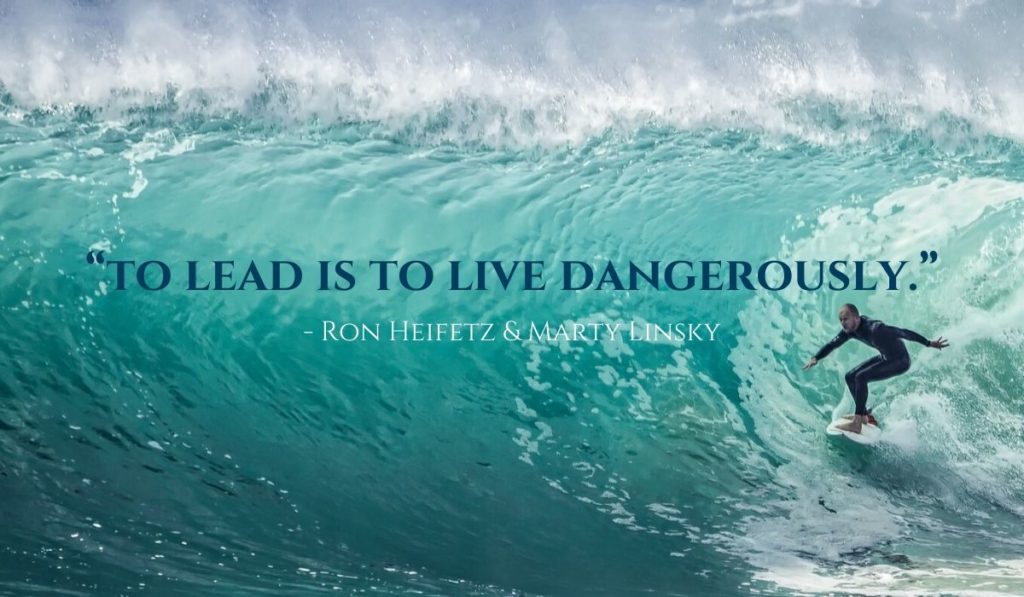What Every Leader Needs To Know

Today’s Challenges
We believe that resilience is the number one characteristic required for leaders today. If we are going to lead teams or organizations through the rapid changes that are rampant in today’s marketplace, we need to not only talk about it, we had better get good at it so we can build teams that are energized and elevated by disruption too.
There are two types of challenges facing leaders and organizations: technical challenges that are resolved by applying expertise; and adaptive challenges that require more than “business as usual” solutions. With the increasing pace of change in organizations, the types of challenges leaders and teams face are becoming increasingly adaptive.
How To Solve Adaptive Challenges
It is no longer enough to do things better, faster, and cheaper. Today’s adaptive challenges require adaptive leadership. The challenge is that adaptive leadership turns everything we know about leadership upside down. When approaching adaptive challenges consider the following principles.
1. Think Differently
Adaptive challenges are more complex and don’t have a simple solution. They require our teams and organizations to create solutions that require us to think differently – radically differently. With adaptive challenges, often defining the challenge itself is the challenge. The more complex and ambiguous nature of adaptive challenges requires leaders to be increasingly more resilient.
2. Ask Tough Questions
Adaptive leadership requires leaders to ask the tough questions. Often, those questions are the ones people are thinking silently to themselves or the politically unsafe questions they dare not ask out loud. They are the questions that surface undercurrents of contradictions in values and behaviors, or in strategy and decisions. They may be critical to the end goal but are “better left unsaid” to those in charge. These kinds of questions might print a big red target on our own heads. The need for resilience is underscored by these corporate realities: It is only a matter of time before an adaptive leader will have to make their own choices about their purpose and decide how important it is to remain in the fight.
3. Mobilize Teams
Adaptive challenges require leaders to exercise a more inclusive style of leadership. Traditional hierarchical leadership defaults to having someone in charge make decisions and then tell people what to do, but in the face of more complex adaptive challenges, this approach can fail miserably. This is because in an adaptive challenge, no one has all the answers, including the person in charge. Adaptive leadership involves mobilizing people to collaborate to solve problems or face opportunities when there is not a clear path forward – because these challenges are too big to be solved by one person’s expertise.
It is no wonder many leaders are exhausted by the systemic drama of the organizations for which we work. Corporate life is tough. Leaders get knocked down, spread thin and asked to deliver more than ever before. It’s hard to be adaptive when we are exhausted.
In their book, Leadership On The Line, Ron Heifetz and Marty Linsky tell us that, “Real leadership – the kind that surfaces conflict, challenges long-held beliefs, and demands new ways of doing things – causes pain. And when people feel threatened, they take aim at the person pushing for change. As a result, leaders often get hurt both personally and professionally.”
What suffers most is the quality of leadership when things get tough, busy or otherwise disrupted. It’s a vicious cycle because the minute disruption hits the quality of “life” for other members of that leader’s team diminishes. Quickly. When people are miserable, results suffer, creating more of a struggle – unless they are resilient and can be energized and elevated by the struggle.
That is why building resilience is so critical in the face of adaptive work.
The LeaderShift® Resilience Workshop is a streamlined program designed to help teams build the skills necessary to thrive in the face of adaptive challenges. The program helps teams build resilience before they need it and provides a framework to act as a guide when disruption hits and urgent decisions need to be made. When complete, the framework acts as a compass pointing towards the organization’s strategic “true north.”
If your organization can use help building resilience to improve your capacity to adapt in the face of disruption, call us. It’s what we do.
*This is an excerpt from Resilience: It’s Not About Bouncing Back, a new book by Jennifer Eggers and Cynthia Barlow now available. Learn more.
